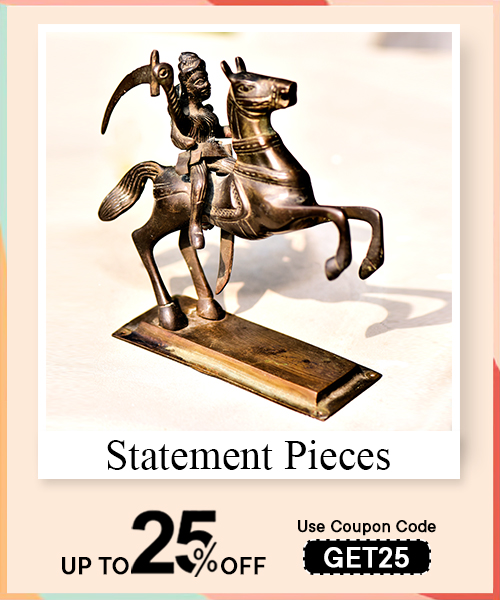India is known for its beautiful culture, beliefs, history, and heritage; in recent years, ancient India’s art of living, particularly meditation and yoga, became widely popular worldwide. Along with the methods and way of life, India is known for its rich art and artistry. Here in India, mainly handmade art is widely celebrated and appreciated. The local artisan and craftsmanship like Bastar art, Dhokra art, paintings, and other local art are famous and cultivated in different parts of the country. The paintings usually include abstract paintings, Canvas paintings, Landscapes, Charcoal paintings, sketch paintings, Tanjore art paintings, Mughal arts, Paintings of Radha and Krishna, Miniature paintings, Needle paintings, oil paintings, Thangka Paintings and Pichwai paintings.
Pichwai paintings hold a strong stance and meaning in history and date back. These paintings usually depict the life of Lord Krishna and significant events in his life. The Life of Krishna and major events include his childhood mischief, defeating evil Kansa, holding Govardhan Parbat on his fingers, etc. These events are beautifully and creatively crafted in the pichwai paintings. Moreover, this painting special set of skill and craftsmanship to dive deep into the intricacies of Pichwai paintings.
In this article, we will talk more about the use of Pichwai paintings.
There are many ways to top a wall, as people live within these walls. There has been a practical approach to date; In the wall texture coat section, draw a pop color here and there, or keep expensive art or rare artwork. But stop thinking about whether these are talking about you, your emotions, desires, or even your preferences.
Dress Up Your Walls With Fabulous Wall Art
If you want to choose the expensive part of the wall art that someone has labeled as unique and worth your money, vs. the cheap, beautiful small art that appeals to your sensibilities, what would you choose? Now, this is the difference between a wall that has been created and a wall that has been combined with love to speak for you. Buy accessible art from a passion; Such as botanicals, birds, butterflies, vintage cars, monuments, wall plates, map art, mirrors, frames, masks - some rare representations of classic and contemporary Pichwai - your walls can do well with anything that appeals to your particular taste.
Pichwai Paintings- A Classic Touch
It should not be about placing decorations that are considered suitable for any wall. It should be about what gives you joy when you look at that wall. The origins of pichwai paintings are in Rajasthan. Classic paintings have deep devotional roots and have been performed by artists with great devotion. Most of the subjects under this style revolve around the image of Krishna, and it is an image of his various moods. Pichwai is also defined as 'pitch' on the back or background and 'wai' like fabric. So, all the scenes behind Krishna act as the background painted on the fabric. Multiple, linearly laid cows are one such version, and it is the most popular symbol in the world of Krishna's earlier devotional depiction. Contemporary presentations are also written on paper.
Master Artistry
Creating a pichwai painting is a daunting task that can take months. It involves using various pigments such as metals, organics, minerals, and synthetic minerals.
Pichwai paintings are full of intricate embroidery, gem work, and fine details. Also, these paintings are not made with regular easels and paintbrushes but rather involve complex strokes by hand while sitting on the floor. These paintings create some beautiful wall art like metal wall art, even without the knowledge of the tradition that they bring. These can be combined with other traditional wall decor pieces and left alone to control the wall space.
You can read also: 15 Creative Wall Art Ideas for Every Blank Spot in Your Home
Handmade Paintings: The Best House Warming Gift Ideas
A Devotional Touch
Pichwai paintings are a significant form of art and are important to millions of devotees of Radha Krishna painting lovers worldwide. Pichwai paintings are filled with interesting tales from Lord Krishna's life, which have expanded into full-fledged themes that segregate different forms of Pichwai art.
Tanjore paintings are also classic paintings that also look elegant on your wall. Typically, Pichwai paintings take weeks to complete and can extend up to several months, depending on the complexity of the art piece.
How are Pichwai Paintings made?
Originally, the pichwai paintings were made on Handspan starch cotton cloth. Craftsmen drew rough sketches on this starchy cloth before filling it with beautiful and decorative details. The colors used are entirely organic, derived from naturally occurring colors derived from gold liquid, silver, zinc, copper, saffron, flowers, leaves, and more. It adds a rich nuance to each complete painting.
The borders of the painting will then be decorated with Kundan stones and other glitter and crystal-like crystals, illuminated light and brightness. The fabric on which the paintings are made has a focal point to create a healthy effect for the temple of Krishna. The tradition has continued ever since. Today, these Pichwai and thangka paintings have a rich artistic heritage and are on the living room walls of art lovers who admire India's traditional handicrafts. You can choose to buy grayscale versions of these works of art. These are often referred to as the 24 forms that explore the real 24 divine forms of Srinathji in mughal paintings or miniature styles. These have little or no historical predominance.
Artistic Beauty-Par Excellence
Some of Pichwai's most famous works of art have sprung by minimizing an ornate image into something more easily usable from this beautiful process of creating an artistic beauty. These include motifs like lotus, cow, tree, peacock, and gopi. It is prudent to note that each of these motifs is symbolic. Although Pichwai art may have originated from a temple, not all paintings are religious. Many pichwai depicts flora and fauna with motifs like lotus, peacock, and cow. These are undoubtedly, an excellent option for large wall fine art for living room decor.
Tracing Rich Past
One of the oldest and most authentic handicrafts in India with rich art history is pichwai paintings. However, in the context of modern times, these have changed and evolved. In other words, the Pichwai paintings that are made today fit the contemporary decor, but at the same time do not compromise with its authenticity and traditional touch. One such significant change is using synthetic dyes in place of completely organic and naturally occurring dyes. Craftsmen are turning to synthetic dyes due to the unavailability of completely natural colors and the long-term need to create natural dyes. Another change is in paintings, where modern artisans limit the fabric's size to fit in small spaces or art galleries. The use of these paintings has gone beyond single-use in worship rooms or temples and is seen as a piece of art hung in the living room or art gallery.
The actual color is the essence of pichwai art. Natural dyes made from gold, coal, silver, blue, zinc, saffron, and other minerals are used for artifacts. Artists grind paint, take dust, and add wood glue to draw their pieces.
To decorate your walls, pichwai paintings are ideal. It brings beauty and spirituality to the room. The labor-intensive process of making it makes a huge difference in your home decor and can instantly enhance your home and its elegance. In addition to gold foil has other distinguishing features - large and wide eyes, a large nose, and a heavy body.
When you place a painting in natural light, it affects its beauty. These delicate designs are exposed to sunlight, ultraviolet rays, and infrared light, which is why these expensive paintings lose their luster. Therefore, keep them away for best results.


























